Intel unveiled 10th generation Core i: codenamed Comet Lake-S, still 14nm but has hit the 10 core 20 thread on the popular PC line
One of the most valuable improvements for users compared to the previous generation is probably Hyperthreading technology, which is disabled on the Coffee Lake refresh line due to security vulnerabilities. Not only that, users can now enable Hyperthreading on each CPU core. Thanks to that, i9-10900K now has a boost frequency of up to 5.3 GHz single core. Apart from the above points, the new generation of Intel CPU is not too outstanding compared to the previous generation, especially when they are still manufactured on the 14nm process. Despite this, Comet Lake-S in general and i9-10900K are still the best gaming CPUs on the market, at least according to Intel's assertion.

This is also the first time Intel has released 32 CPUs simultaneously for the desktop PC market. Especially the series appearance of CPUs with the suffix F (not equipped with integrated graphics core) and T (CPU with a power consumption of only 35W, optimal for small-form compact machine design) factor, which has been a trend of machine build for 2 years).
With the tradition of 2 generations of CPU changing socket once, in the 10th generation, Comet Lake S will use LGA 1200 socket to match the power requirement of 125W or more in CPUs with K suffix (open system) multiplier for overclocking). This is also the weakness of Intel CPUs at the present time when compared to rivals from AMD. One thing is for sure, no Intel mainstream CPU can beat the Ryzen 9 3950X with 16 cores and 32 threads of computing performance. Therefore, in its media publications, Intel mainly emphasizes on single-core performance as well as the ability to play and run applications of Adobe, which is the strong point / multiplier of the CPU of AMD. still cannot reach.
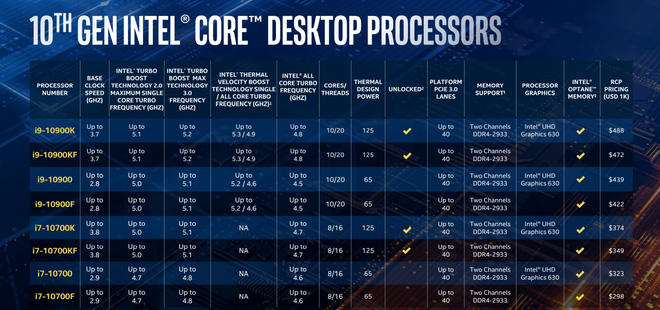
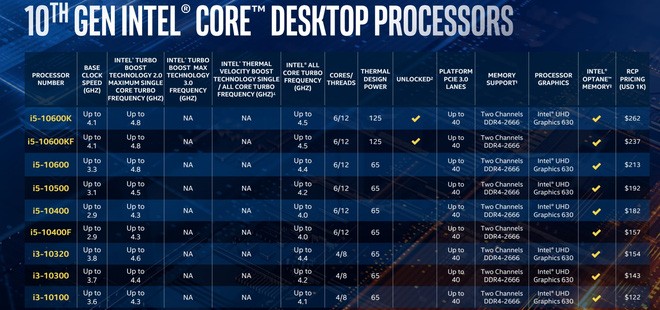
Brandt Guttridge, senior director of desktop and workstation marketing at Intel, explained that Intel's current goal is to improve actual clock, overclocking and performance. We can see the battle in the mainstream CPU market getting hotter day by day. Leading the Comet Lake-S is the Core i9-10900K, which is listed at i9-9900K at $ 488. However, to choose the best p / p (performance / price) CPU, the Core i5-10600K with 6 cores and 12 threads promises to be the market leader. The problem is that the power of Comet Lake-S comes with a small price. The index of power consumption and TDP generation temperature of Core i Generation 10 reached 125W, about 25% compared to 95W of 9th generation. Meanwhile, AMD Ryzen 9 TDP of 3950X (16 cores) / 32 streams) and 3900X (12 cores / 24 streams) at 105W only.
Comet Lake-S's auto-overclocking-boosting capability is also new. While Turbo Boost Max Technology 3.0 has been available on the Broadwell-E series since 2016, this is the first time this technology has been applied on mainstream CPUs. In particular, this overclocking technology will choose a core is said to be the most powerful to overclock. The improvement after 4 years is that Comet Lake CPUs will choose up to two cores to overclock without increasing the input voltage.
In addition, the i9 CPUs are equipped with Thermal Velocity Boost technology, with the ability to read information from the CPU's temperature sensor to add 200 MHz of clock speed if the system is equipped with a powerful enough heat sink. Not only the processor core, but the UHD 630 graphics cores will also be overclocked from 350 MHz to 1.2 GHz if needed.
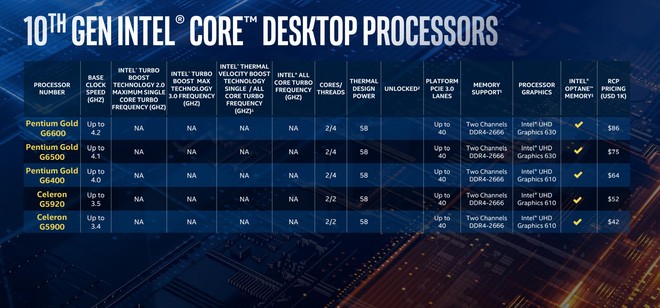
In the "carpet" market, Intel also released up to eight models of low-cost CPU under $ 100 with a TDP of only 58W. This is also the segment where Intel will continue to dominate with five Pentium Gold CPUs equipped with Hyperthreading technology. Only three Celeron CPUs do not have hyperthreading technology.

Finally, it is impossible not to mention the CPU with the suffix T of the energy-saving CPU series, serving the next generation Intel NUC as well as small SFF devices. Despite having a TDP of only 35W, Comet Lake-S's T-series CPUs include such giants as the i9-10900T and i7-10700T.
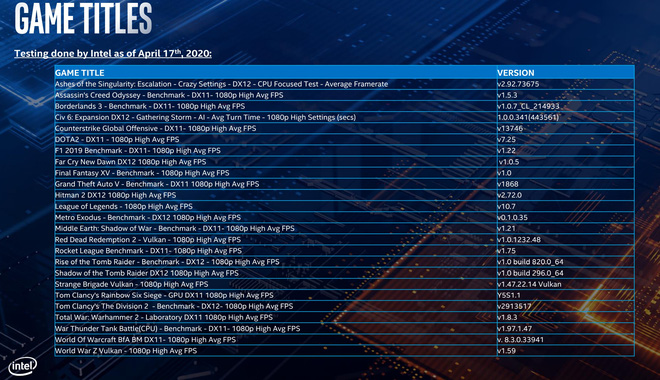
In terms of performance, despite being technologically lagging behind with 14nm transistors (5 times improved), the overall performance of Intel Comet Lake-S CPUs is still formidable, on par with the 3rd Generation Ryzen CPUs with 7nm transistors and AMD price range. Anyway, Intel's transistor density is still superior to the opponent, for example, Intel's 14nm process is still more dense than TSMC's 10nm (AMD's chip processing company). At this point, when Intel introduces the 10nm CPU, its performance will definitely surpass to bring Intel once again to the top position. Going back to the present day, the Core i9-10900K will help Intel to firmly build the throne in the game when surpassing Ryzen 9 3950X in 25 games.
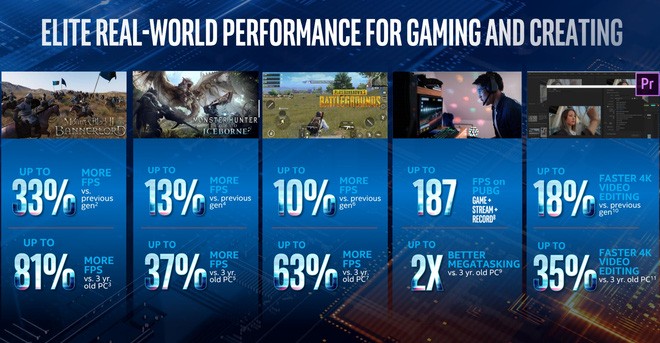
Intel still holds its own view that actual performance is important, not benchmarks. Even Intel also brought the i9-9900K and i7-7700K itself to compare. When paired with the Nvidia RTX 2080 Ti, Comet Lake-S's flagship CPU brings performance improvements of up to 81%.
Intel's reason (or excuse) for overclocking itself on certain CPU cores is based on their research: 95% of systems with Steam installed use at most 6 CPU cores. Therefore, the clock on 6 CPU cores will be the most important factor to improve performance. In parallel, the ability to turn off Hyperthreading on CPU cores is not used to optimize the temperature. This technology may soon be learned by AMD to solve the temperature problem on their high-end CPUs.
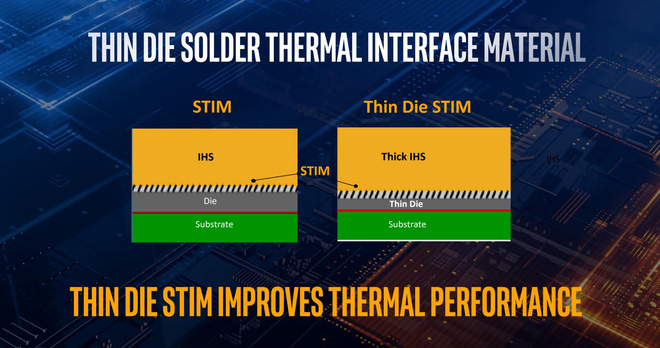
Also because of trying to cram more CPU cores, temperature is the most headache of Intel issues on the new generation of CPU. To solve this problem, the blue team had to improve both the chip base design and the thermal pad. Now, the CPU silicon base will be thinner while the IHS thermal pad will thicken to lead more heat.
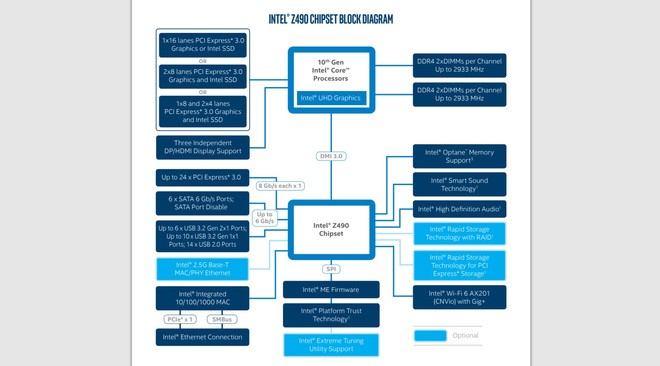
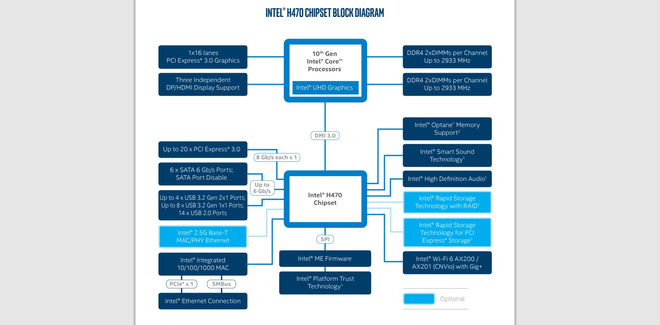
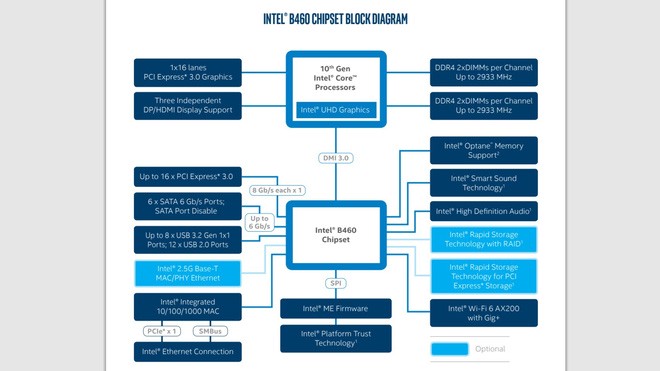
Along with the 10th generation Core i are four new 400 series chipsets, still based on the old naming: Z490, H470, B460 and H410. The most disappointing thing about this chipset generation is probably still only supporting PCI Express 3.0 protocol while the motherboards on the other side of the line have been equipped with PCI Express 4.0 since the end of last year. On the other hand, the four newer chipsets are not very different from their predecessors, except for the extra support for Wi-Fi 6.
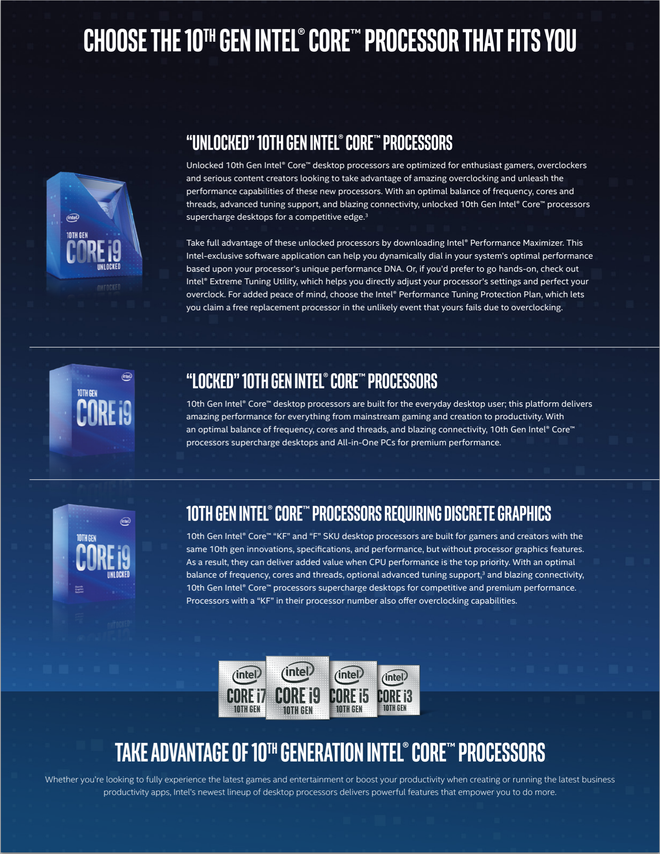
All in all, the 10th-generation Intel Core i can still be considered an improvement of about 25% over the previous generation, according to its long-standing tradition. Not to mention this time, Intel also launched a completely new product packaging, different from previous generations. However, Comet Lake-S is not really a worthwhile upgrade, especially when you own a desktop equipped with Coffee Lake. It is also worth noting that AMD's credit is extremely large when users now only need to spend 300 USD to have the i7-10700K 8 cores 16 threads, double the figure of three years ago of i7-7700K in when the same price range. The actual performance of this CPU series will soon be assessed by us in the near future.
You should read it
- Intel released the new generation Comet Lake vPro processor, promising many valuable improvements
- Core i7-10700KF revealed benchmark score, as strong as Ryzen 7 3800X but doubled power consumption
- Intel Core i9-10900K Review: Named the best gaming CPU on the market
- Intel released the 10th generation H series CPUs for laptops, promising outstanding performance
- Intel Core i5-10600K review: The most affordable gaming CPU today
- Can Intel reduce product prices before AMD Ryzen 3000 officially launches?
- Top best CPU for PC 2020
- Intel announced the new Gen 10th Comet Lake desktop CPU: still 14nm but max clocked up to 5.3GHz
May be interested
- Benchmarking route of Coffee Lake - 8th generation Intel chip
 last month, intel unveiled its first 8th generation core i cpu. recently, there was the benchmark score information of coffee lake - the latest generation intel chip. let's see what's special in this benchmark!
last month, intel unveiled its first 8th generation core i cpu. recently, there was the benchmark score information of coffee lake - the latest generation intel chip. let's see what's special in this benchmark! - Intel Core i5-10600K review: The most affordable gaming CPU today
 continuing the tradition of the core i5 series, i5-10600k once again occupies the throne in mid-range gaming
continuing the tradition of the core i5 series, i5-10600k once again occupies the throne in mid-range gaming - Hubble Space Telescope has just captured the 'crumbling moment of Comet Atlas'
 comet atlas has completely shattered into dozens of large pieces, ending his famous life.
comet atlas has completely shattered into dozens of large pieces, ending his famous life. - What is thread? Differences between Process and Thread
 thread and process, these are terms that you will hear a lot if you study information technology, and need to understand when going to work. however, the definition and the difference between them is not well known, because they may not be in the knowledge taught by the school.
thread and process, these are terms that you will hear a lot if you study information technology, and need to understand when going to work. however, the definition and the difference between them is not well known, because they may not be in the knowledge taught by the school. - Intel launches 14th generation 'Raptor Lake-S Refresh' processor line
 after countless rumors and leaked information, intel has finally officially launched the 14th generation core processor line codenamed 'raptor lake refresh'.
after countless rumors and leaked information, intel has finally officially launched the 14th generation core processor line codenamed 'raptor lake refresh'. - Microsoft lists supported CPUs from the Meteor Lake 'Core Ultra' series and next-generation Raptor Lake
 microsoft has listed a number of upcoming intel cpus in support for windows 11 22h2 & 23h2, including the meteor lake core ultra and raptor lake refresh series.
microsoft has listed a number of upcoming intel cpus in support for windows 11 22h2 & 23h2, including the meteor lake core ultra and raptor lake refresh series. - Core i7-10700KF revealed benchmark score, as strong as Ryzen 7 3800X but doubled power consumption
 the early signals are not optimistic for intel.
the early signals are not optimistic for intel. - Intel launches 10th-generation Core X-series processors, the most powerful model with 18 cores priced under $ 1,000
 the strongest mode is the core i9-10908xe 3ghz (accelerated to 4.8 ghz) with 18 cores and 36 processing threads.
the strongest mode is the core i9-10908xe 3ghz (accelerated to 4.8 ghz) with 18 cores and 36 processing threads. - Revealed 11 Intel's first generation 10 Ice Lake CPU models
 11 generation 10 ice lake cpus will have all models from core i3 to core i7 and are named in the familiar way of intel, starting with 2 numbers 1 and 0 respectively for generation 10.
11 generation 10 ice lake cpus will have all models from core i3 to core i7 and are named in the familiar way of intel, starting with 2 numbers 1 and 0 respectively for generation 10. - Revealed Intel Core i9-12900K Alder Lake-S CPU configuration with 16 cores, 24 threads, supports DDR4 RAM
 relatively detailed information about intel's high-end core i9-12900k alder lake-s cpu model has just been unexpectedly found in the database of the userbenchmark hardware review site. the chip was found to be running on a high-performance desktop platform, and has an impressive configuration
relatively detailed information about intel's high-end core i9-12900k alder lake-s cpu model has just been unexpectedly found in the database of the userbenchmark hardware review site. the chip was found to be running on a high-performance desktop platform, and has an impressive configuration










 The new DisplayPort specification enables 16K video transmission via USB-C
The new DisplayPort specification enables 16K video transmission via USB-C MSI introduces new generation motherboards that support 10th Generation Intel Core I processors
MSI introduces new generation motherboards that support 10th Generation Intel Core I processors VOOC charger kickstarts the era of fast charging for mid-range smartphones
VOOC charger kickstarts the era of fast charging for mid-range smartphones How to replace the iPad battery
How to replace the iPad battery How to install RTX Voice on a GTX card in Windows
How to install RTX Voice on a GTX card in Windows